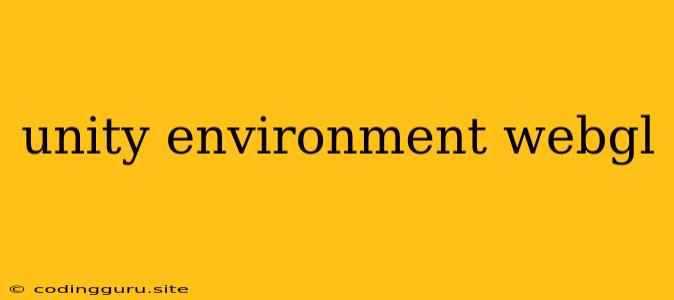Building Immersive Experiences: Unity WebGL for the Web
The web has become a powerful platform for delivering interactive content, and Unity WebGL is a leading technology enabling developers to bring their Unity creations to life on the web. But what exactly is Unity WebGL, and how can you leverage its capabilities to build engaging web experiences?
What is Unity WebGL?
Unity WebGL is a powerful tool within the Unity game engine that allows you to compile your Unity projects into web-compatible applications. This means you can deploy your 3D games, interactive simulations, and other immersive experiences directly within a web browser, reaching a broader audience without needing specialized software or plugins.
Why Choose Unity WebGL?
Unity WebGL offers several advantages:
- Cross-Platform Compatibility: WebGL projects are compatible with various web browsers across different operating systems, expanding your potential reach.
- Accessibility: Users can easily access and interact with your Unity creations without needing to download or install any software.
- Web Integration: Unity WebGL allows seamless integration with other web technologies, including HTML, CSS, and JavaScript.
- Performance: While WebGL's performance is constantly improving, it's essential to optimize your projects for the web environment.
Setting Up Your Unity WebGL Project
To embark on your Unity WebGL journey, follow these steps:
- Create a New Project: Begin by creating a new project in Unity.
- Configure WebGL Settings: Navigate to Build Settings and select WebGL as the platform. You can adjust various settings, such as the target browser, compression, and loading progress bar.
- Build the Project: Once you've finalized your project and settings, click the Build button. This will create a folder containing all the files necessary to deploy your Unity WebGL project.
Important Considerations for Unity WebGL
Unity WebGL offers tremendous potential, but keep these points in mind:
- Performance Optimization: WebGL relies on the browser's graphics processing capabilities. To ensure a smooth and enjoyable experience, optimize your project's graphics, textures, and code for efficient performance.
- Browser Compatibility: While WebGL enjoys wide browser support, it's crucial to test your project thoroughly across various browsers to ensure compatibility.
- Security: Pay attention to security best practices when developing for WebGL, including protecting sensitive data and implementing secure communication protocols.
Examples of Unity WebGL in Action
Unity WebGL has been used to create a wide range of exciting web experiences:
- Interactive 3D Games: Games like "WebGL Tanks" and "WebGL Tetris" showcase the potential of Unity WebGL for engaging gameplay.
- Virtual Tours and Experiences: Real estate companies use Unity WebGL to create virtual tours of properties, while museums and cultural institutions leverage it for immersive historical exhibits.
- Educational Simulations: Unity WebGL empowers educators to create interactive simulations for science, technology, engineering, and mathematics (STEM) subjects.
Conclusion
Unity WebGL is a versatile technology that empowers developers to bring their Unity creations to the web, offering a unique opportunity to reach a broader audience with immersive and interactive experiences. By understanding the fundamentals, optimizing for performance, and considering security best practices, you can leverage the power of Unity WebGL to build compelling and engaging web applications.
